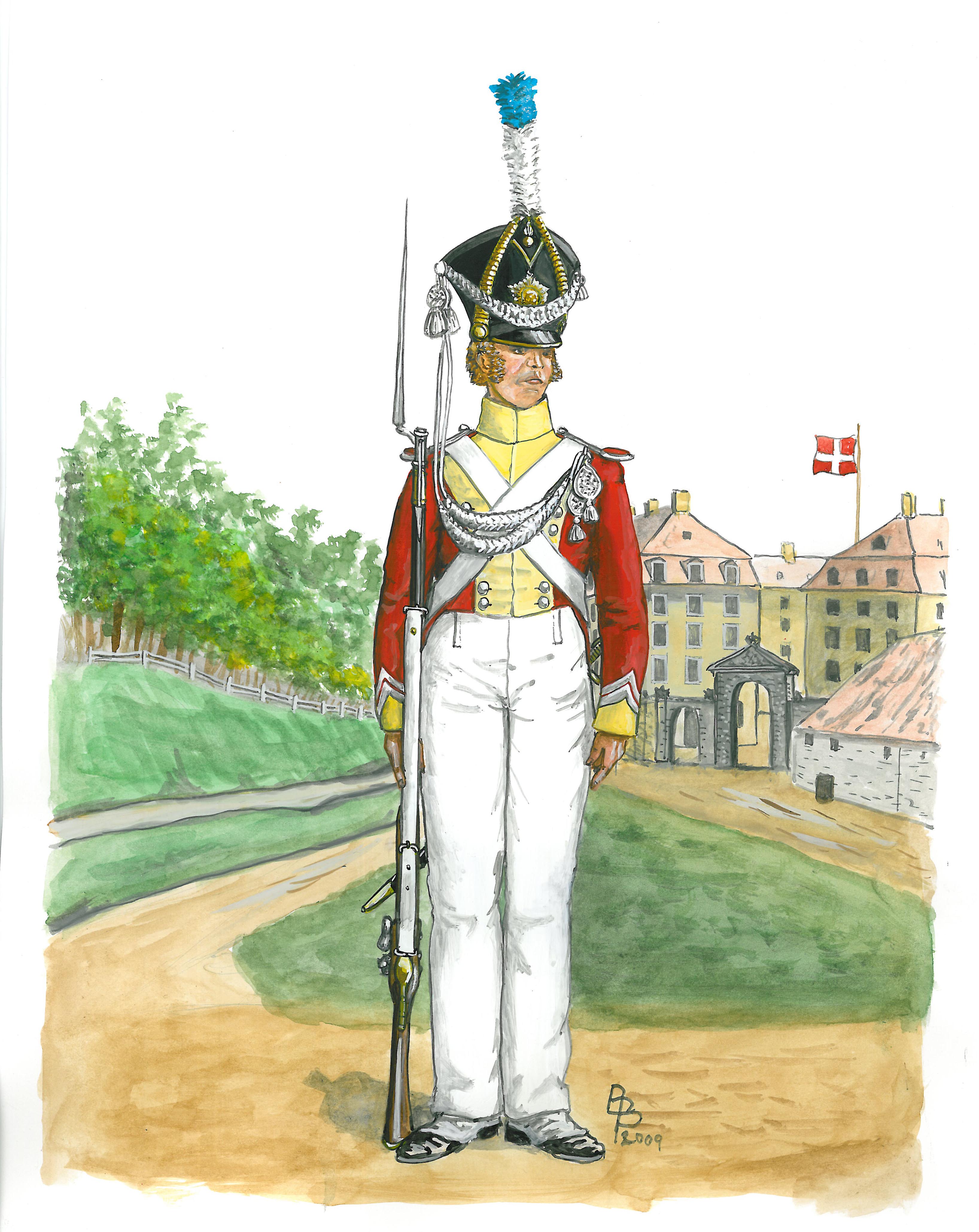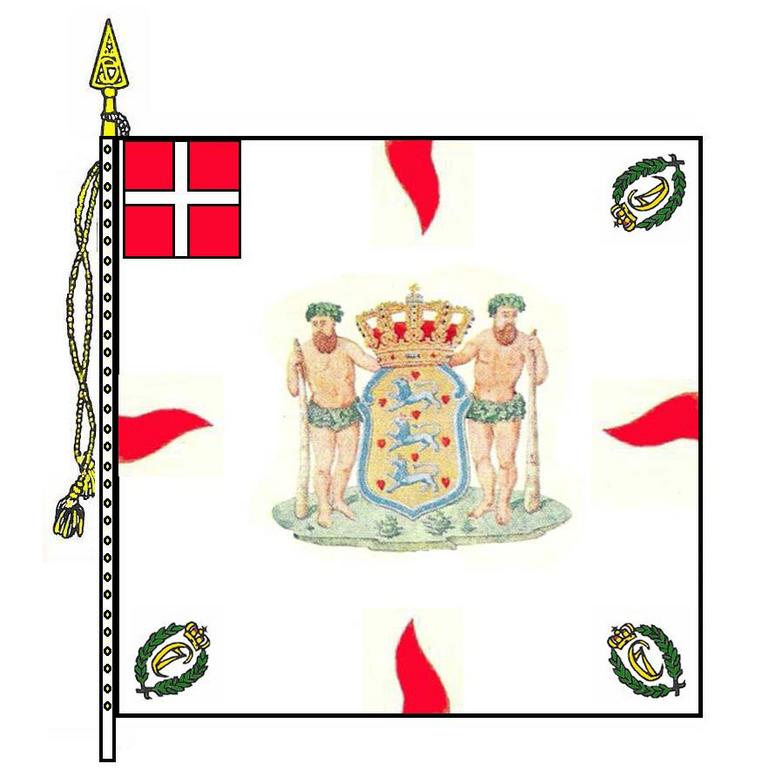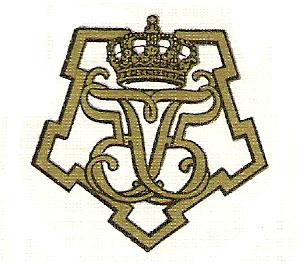DENMARK
THE DANISH LIFE REGIMENT
Grenadier Corporal
1st Line Infantry Regiment
1835
The Regimental Colour in 1835
After the end of the Great Northern War in 1720, Denmark enjoyed a long period of peace and was an onlooker while the great dynastic struggles of the War of Austrian succession and the Seven Years War tore Europe apart. It was at the end of the latter period that this peace was rudely, but briefly interrupted. Peter III of Russia, son of the dead, former Duke of Holstein-Gottorp married to a sister of Czar Peter the Great, newly acceded to throne in 1762, was also the Duke of Holstein-Gottorp and had ambitions to retake the provinces of Schleswig-Holstein, taken in 1704 by Denmark-Norway from his family. Being a great admirer of Frederick the Great, the new Czar at once made peace with his idol and joined him in a coalition, so saving the Prussia from a sure defeat. The Prussian king heartily supported his new, young friend and promised him Prussian troops if need should be to defeat Denmark. The king of Denmark was not very popular among the rulers of Europe for 1756-1762 having kept a large standing army at the southern border, paid for with subsidies from France, so Denmark stood alone against the coming onslought from Russia. The Danish king in this situation hired one of Europe’s best generals, the French count Saint Germain, one of the few French generals respected by Frederick the Great. With great energy Saint Germain put the outmoded Danish Army in a reasonable condition and marched with this into Northern Germany to await the oncoming Russian army in the passes there. The face-off ended - only one days march separated the armies - as suddenly as it began, when news arrived that Peter had been overthrown by his wife the future Catherine the Great and murdered by some of her lovers. The crisis over Saint Germain set to work to modernize and slim the Danish Army. The 3 regiments of the Guards (The Life Guard, The Grenadier Corps and the Horse Guards), very costly to upheld in their former size, costing together as much as the rest of the army, were reduced from normal regimantal size to only small place guard detachments and the Grenadier Corps disbanded. The surplus of officers and men left over from this prudent
reorganizing were used to form the new regiment Danish Life Regiment of Foot (Danske Livregiment til Fods), incorporated on December 7th, 1763. The regiment was garrisoned in and around Copenhagen and from 1773 to 1852 (with few interruptions) was quartered in the Sølvgades Barracks. The regiment first saw action on 2nd April 1801 at the Battle of Rheden, known to the British as the Battle of Copenhagen. 150 men had been told off as soldateske and man the floating gun batteries to assist the Danish Navy in its defense of the capital. Despite the decisive defeat, the results of the action, designed to prevent Denmark from combining with Russia and Sweden to trade with France, were moot. The Tsar of Russia, Paul I, had been assassinated by his own court on March 1st and replaced by his anti-French son Alexander I. In August of 1807, the regiment was again called to defend the capital at the second battle of Copenhagen. This time the British had come to neutralize the Danish fleet, lest it be used against them by Napoleon. Following his victory over the Prussians at Jena, it was thought he may have had his eye on Denmark, who possessed the largest left navy not controlled by England. The Duke of Wellington led the British troops who at landed at Wedbeck (Vedbaek) on the 16th and after a brief engagement had completely surrounded the city by the next morning. The operation went smoothly, as the whole Danish Army was concentrated on the southern border in Jutland to defend against a very possible French attack and invasion. Left for the defense of Copenhagen were only the Life Regiment, the small Guards and a few volunteer units. The ensuing siege, begun on the 2nd September included the ghastly bombardment of the city by the Royal Navy which lasted until the 7th when the city surrendered. The British forces, mostly from the King’s German Legion then left for home in mid October taking captured Danish vessels ships after destroying the remainder. During the siege, the Life Regiment took part in several of the sallies one going from Norreport to Vibenshus to take up position on the western side of the city to cover an attempt to halt building of English batteries. Their one encounter with the invaders was a short sharp fight fought with the bayonet which prevented the enemy from passing but cost the regiment 5 dead and 35 wounded. The Danish Life Regiment was not part of the Danish Auxiliary force that fought together with Napoleons Army in the waning days of his Empire, 1813-14. In 1819 the regiment’s name was changed to 1st Life Regiment of Foot and reduced from its war establishment of four battalions to two battalions each of 5 companies.
In 1842, after the death of the old king, Frederik 6, the Danish Army was modernized and downsized for econmic reasons. All standing infantry regiments became battalions, which in case of war would be strengthened with reserve battalions, but still retained its place as the first Battalion of line infantry. In 1848, the revolutions that swept Europe also came to Denmark. It was a civil demonstration in Copenhagen that lit the spark by prompting Germans in Schleswig and Holstein to clamor for attachment to the German Federation. As is often the case, the issue spiraled out of control until, on the orders of the Frankfurt Diet, German troops, led by Prussia invaded Schleswig to back up the forces already organized by the two duchies. Intervention by the European powers and the landing of Swedish troops in 1850 forced the Franfurt Diet to the negotiating table. The 1st Life Battalion (now formed as a light infantry battalion until 1855) fought with great distinction in the campaign, especially at the battles of Bov (a Danish victory) and Schleswig in 1848, Frederica in 1849 and Isted in 1850.
In 1864, the situation blew up again, this time by unfortunate decrees of the Parliament toward the status of the two duchies and Otto von Bismarck’s forced subsequent exploitations. Despite European objections, the Austrians and Prussians invaded on the 6th February 1864. The rearguard action at Sankelmark by the 1st Life Regiment, held up the Austrian pursuit long enough for most of the Danish Army to retreat from the defence works at Dannevirke in a rather orderly fashion. However, most of the regiment was subsequently taken prisoner. For their collective act of courage a song entitled “Thank You For Your Deed” was dedicated to the regiment. Within a month the Prussians had advanced to Düppel and invested the position and it fell on April 18th.
The truce, demanded by the European Powers, which followed led nowhere. After the Island of Als was invaded on June 29th and the Danes had fought a brief action with the Prussians at Lundby on July 3rd, the whole of Jutland was occupied. The Danes were eventually forced to cede Schleswig and Holstein to the Austrians and Prussians who set up a condominium, the management of which led to tension between the two countries and was among the reasons for the war in 1866.
Denmark was to be a neutral country for the next 76 years and their army was trimmed accordingly. In 1865 the regiment was reduced to a 4 company battalion and in 1867 it became the senior battalion in the 1st Sjaelandske Brigade which included the 15th, 21st and 31st battalions. In 1880 the half-brigade system returned to stand alone battalions. For the entire period of 1914-1918, the regiment remained on high alert at the border without incident but in 1940 was overwhelmed by the order not to fight and speed of the German advance. Many of the personnel later went into the resistance work. At the end of the war, the Soviets were poised to occupy Denmark but fortunately, British forces (one general with eight paratroopers!) arrived in time to prevent this. After the war, Denmark joined NATO and in 1951, the regiment was named the Danish Life Regiment again. The last half of the 20th century saw
Danish troops heavily engaged in a UN and NATO peacekeeping role. In 1976 the regiment was amalgamated with the Falsterske Infantry Regiment becoming an armored infantry unit. The title “Danish Life Regiment” was retained and in 1991 it was tasked to train and establish combat units and has thus served in Bosnia (UNPROFOR & IFOR), Kosovo (KFOR & SFOR) and Afghanistan (ISAF). In 2000 the Danish army underwent a major reorganization; a process that is still ongoing. The Life Regiment was absorbed into the Guard Hussar Regiment to form an armored combat and training regiment and as such ceased to exist. A proud and distinguished regiment had passed into history.
UNIFORMS
When raised in 1763 the regiment was dressed in accordance with the rest of the infantry, red coats with different coloured lapels and cuffs, straw coloured waist coat and breeches. The first years the regiment had blue lapels and cuffs, then changed to straw. In 1770 grenadiers were still wearing the mitre cap M. 1768 with brass plate and black bottom with a red bag striped white. In 1789 a new cut of the Danish uniforms was introduced copying the Russian Potemkin style. It was a short jacket without the long tails of the former coatee. The front skirt flaps were turned up on each side like the Russian model. The jacket had lapels and cuffs in regimental colour (straw) and eventual piping (white), while the front flaps were straw coloured, later white. The cuffs had red three pointed patches piped white. The gaiterbreeches were pale grey in winter, white for summer. A black round hat was introduced 1789 with the left side turned up and a white plume. Grenadiers wore a distinctive headdress which was an imitation of the Russian 1786 cap. It had a high black lacquered front with a white fur crest around the top. The plate was “held” by bands in regimental color (red for regiments with black facings) hanging down from the rear - just like the Russian model. In 1808 shakos were introduced for musketeers, while grenadiers in 1803 had got fur grenadier caps on the Austrian model. White breeches with black gaiters were taken into use from about 1810. From 1816 coatees of more conventional cut with lapels, collar and cuffs were worn. Turnbacks were white.
For the next 30 years the Danish line infantry followed the general European fashion. The coatee was red with collar, cuffs and lapels in facing color, which for the Danish Life Regiment remained pale yellow. The cuffs became pointed in 1816. Trousers were white in summer and at first grey, later light blue in winter. The head dress was the shako was of black felt with leather binding top and bottom and some regiments had V shaped leather stiffeners on the sides. The shakos followed the fashion of the day, first a model like the Russian kiwer was in use. Center companies had a ball tuft, grenadier companies a light blue over white feather and light companies a green plume with green loops across the front. In 1842 the different facing colors of all infantry battalions were abolished and a standard uniform was adopted. The coatee was red with a double row of buttons down the front. The collar, pointed cuffs and trousers were light blue and piping on collar, cuff tops, front edge of coatee and turnbacks were white. The shako assumed a more pronounced bell and was quite plain except for a v-shaped loop on the front surmounted by a white ball tuft.
A completely new uniform was authorized in 1848, but its introduction was hindered by the war that broke out the same year. The Danish infantry now assumed a look that would define its appearance until the First World War. The long skirted double breasted tunic was blue, piped red on tunic front, pointed cuffs and skirt flaps. The blue collar had red patches with two buttons and red lace loops. The shako was at first the same as that introduced in 1842. In the field, a light blue “Hungarian” peaked cap was preferred. The trousers were light blue. The Danish Life Regiment at this time was Light Infantry and so its tunic was dark green and the trousers were dark grey. Facings and all other features were the same as for infantry.
There were few changes for the rest of the century and the modifications made were in line with the fashions of the times. In 1855 a low dark blue kepi was introduced. One defining feature of the Danish army that would survive into the nineteen-fifties was the way they wore their trousers rolled half-way up the calf in summer, rather than tucked into the boots. A grey field uniform was introduced in 1915 and was worn till World War II despite a khaki version authorized in 1923 but not even issued to some units till 1937. After the war the development of Danish army uniforms was very conventional. They wore US style steel helmets until the late eighties when French, later German Kevlar helmets were introduced.
The Last Badge of the Regiment
Our illustration shows a grenadier company corporal of the 1st Life Regiment of Foot in about 1835. His shako has the light blue over white tall plume with white shako cords and loops with tassels and flounders pinned to his chest. The front is adorned with a grenade below the plume socket and an eight pointed brass star with the royal cipher in the center. His corporal’s rank is shown above his cuffs. The shako for center companies of the regiment had a white ball tuft and a plain brass V on the front. The light company had the same shako as the center company with green ball tuft and all their leather work was black.
In the background is the main entrance to the Sølvgades Barracks in Copenhagen, where the regiment was garrisoned for much of its existence.
Names of the Regiment
1763 Danish Life Regiment of Foot
1819 1st Life Regiment of Foot
1842 1st Line Infantry Battalion
1848 1st Light Infantry Battalion
1855 1st Line Infantry Battalion
1860 1st Infantry Battalion
1863 1st Infantry Regiment
1867 1st Battalion
1951 1st Regiment
1961 Danish Life Regiment
2000 Absorbed into Guard Hussar Regiment










